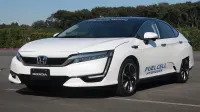Honda: We won’t be able to sell ICE cars in China by 2025

Ohtsu foresees China adopting some of the strictest fuel economy standards in the world in the coming years. “In 2025, we don’t expect to be able to sell conventional internal-combustion engines [there], meaning we will be selling mostly hybrids including plug-in types,” he said to WardsAuto.
China’s push to clean up its air comes as major cities continue to struggle with massive levels of pollution. For example, Beijing recently banned half of the cars from the road due to dire levels of smog. To fight back, the government has pushed automakers to launch more plug-ins, and the strategy has shown some success. China’s BYD has already become the world’s largest producer of plug-in vehicles in 2015.
Even outside of China, Honda intends to become a far greener automaker in the coming years. In the near term, the company expects 20 percent of its global volume could be hybrids by 2020. According to Ohtsu, as much as 80 percent of Japanese deliveries could have some form or electrification by that time, but the US would be closer to 20 percent.
However, the company sees hybrids more as a stepping stone than as the future of motoring, and the mass adoption of hydrogen is the real goal. “We think that fuel-cell vehicles will come into the mainstream in 2030, along with battery-powered electric cars. We also feel that going forward hydrogen will be the best fuel alternative,” Ohtsu said to WardsAuto. Honda’s experimental FCEV (pictured above) already hints at the brand’s future direction.




